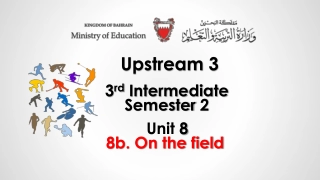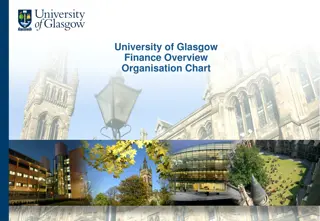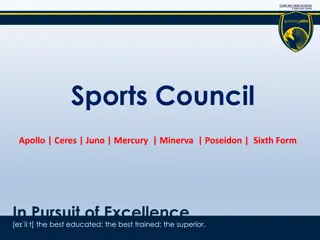SPORTS FINANCE AND MANAGEMENT
This book delves into the intersection of real estate, media, and sports management, providing insights on the evolving landscape of the sports business industry. It discusses the impact of media on sports finance and management, as well as the role of real estate in shaping the new dynamics of the sports world. Written by Jason A. Winfree, Mark S. Rosentraub, Brian M. Mills, and Mackenzie P. Zondlak, this publication offers a comprehensive look at the complex relationships between these key sectors.
Download Presentation

Please find below an Image/Link to download the presentation.
The content on the website is provided AS IS for your information and personal use only. It may not be sold, licensed, or shared on other websites without obtaining consent from the author.If you encounter any issues during the download, it is possible that the publisher has removed the file from their server.
You are allowed to download the files provided on this website for personal or commercial use, subject to the condition that they are used lawfully. All files are the property of their respective owners.
The content on the website is provided AS IS for your information and personal use only. It may not be sold, licensed, or shared on other websites without obtaining consent from the author.
E N D
Presentation Transcript
SPORTS FINANCE AND MANAGEMENT Real Estate, Media, and the New Business of Sport Jason A. Winfree, Mark S. Rosentraub, Brian M. Mills, and Mackenzie P. Zondlak
Chapter 1 Redefining the Sport Business Industry
Challenges Facing Sports Managers Today Every business is challenged to keep pace with increasingly dynamic and rapidly shifting market conditions. These are just some of the examples of how every business must adopt and adapt to emerging technologies and customer preferences. businesses and their managers must (1) adapt their financing and management skills to meet consumers expectations; (2) identify new revenue streams and opportunities; (3) carefully evalu-ate the profitable potential of these new revenue streams, products, and methods of delivery; and (4) respond to the expanding range of choices made available by the Internet. Those businesses and managers that are unable to innovate and adapt to the real- time age of the Internet and the various other demands of consumers for enhanced experiences will be less financially successful.
Change Number 1: Ownership Models In the past, individuals, families, and partnerships were the dominant forms of ownership models. Teams are now often part of a conglomerate that, at its center, could be a media, entertainment, food services, or real estate business. The team then becomes an integral part of the empire and the owner lever- ages the unique value of sport and the team s identity for the benefit of the conglomerate. Another business institution has also become part of sport world: hedge funds. Foreign investors have also bought teams.
Change Number 2: Sport, Entertainment Complexes, and Real Estate Development Enhancing revenues and the value of a franchise is the top priority for professional staff on the business side of a team s operations. The quality of the at-home experience for fans since the advent of large- sized HD televisions has meant that new and unique experiences must exist at a venue to attract fans. The popularity of sport has made it possible to build new urban neighborhoods complete with residential, entertainment, and commercial properties anchored by arenas, ballparks, and football stadiums.
Change Number 3: Young Fans and Their Loyalties The need to focus on new experiences at venues or in adjoining neighbor- hoods has also been driven by the spectacular increase in the popularity of fantasy teams.
Change Number 4: A New Media World There has been a decline in attendance at college football games and for some professional teams. When attendance declines, it is probably more related to the quality of the fan experience in or near a venue than a team s performance. What is also evident, however, is that communications and the media are now among the most important revenue streams for teams. Sport has become synonymous with media exposure and that connection has con- tributed to the escalating value of teams. Understanding the sport business in real time requires an appreciation for how quickly the dynamics of the relationship between sport and television, and sport and the Internet, has changed. In turn, these changes have had and will continue to have profound economic consequences for teams, leagues, and universities.
Change Number 5: The Real Estate Management Issues within Venues
Change Number 6: League Policies majority of these conflicts arise due to the simple fact that some teams operate in large markets, while others serve fans in much smaller metropolitan areas. Further, certain markets are much wealthier than others. San Francisco San Jose region Jacksonville or even metropolitan Atlanta. The resulting unequal distribution of wealth provides teams in the larger and wealthier regions with the potential to earn more money than those in smaller areas. Those differences may give incentives for a variety of league policies. Salary caps divide the financial pie between owners and players, but managers also need to understand how and why a salary cap could lead to lower revenues for both players and owners.
Change Number 7: The Globalization of Sports The sport business has gone global. The existence of the Olympics and the worldwide appeal of soccer, tennis, golf, racing, gymnastics, ice skating, ice hockey, basketball, skiing, and rugby. What has changed is the ways in which the North American sport leagues are interacting with the rest of the world and the extensive televised presence of England s Premier League matches in North America. FIFA s World Cup and the European Championship are some of the most valuable tournaments and many of those players do not compete in the Olympics.
Change Number 8: Teams and Public/Private Partnerships Increased public investment in sport venues reached its zenith in the 1990s. Each time one of these public/ private partnerships was created, there was opposition from some taxpayers and voters There are ways to build effective partnerships producing financial benefits for teams and cities. Those professionals preparing for careers in sport finance and management must be able to advance a team s interests while also ensuring that real economic benefits exist for the public sector.
Change Number 9: The Landscape of Collegiate Sport and NCAA An extraordinary set of changes in college sport. At one level, the most successful athletic conferences, several individual universities, and the NCAA itself are generating a substantial amount of money from media contracts, ticket sales, donors, and tournaments. At another level, some student athletes believe they are not being fairly compensated for the revenues they produce while college coaches and athletic directors earn salaries that eclipse those earned by most if not all faculty members and university presidents. The NCAA argues that amateur status is needed to maintain a level of parity

 undefined
undefined





























